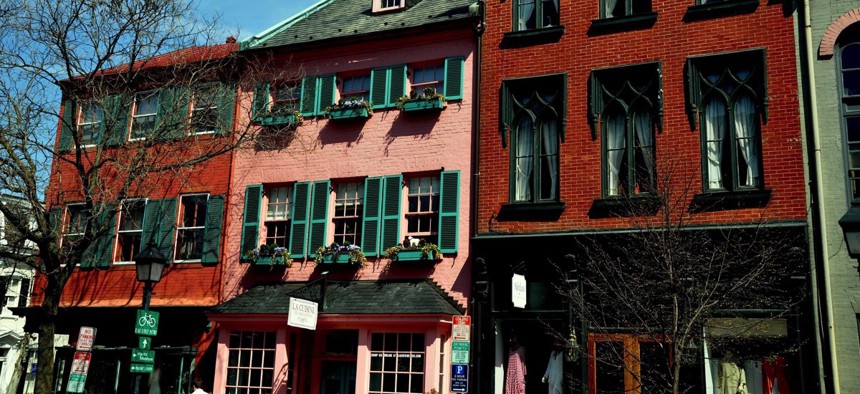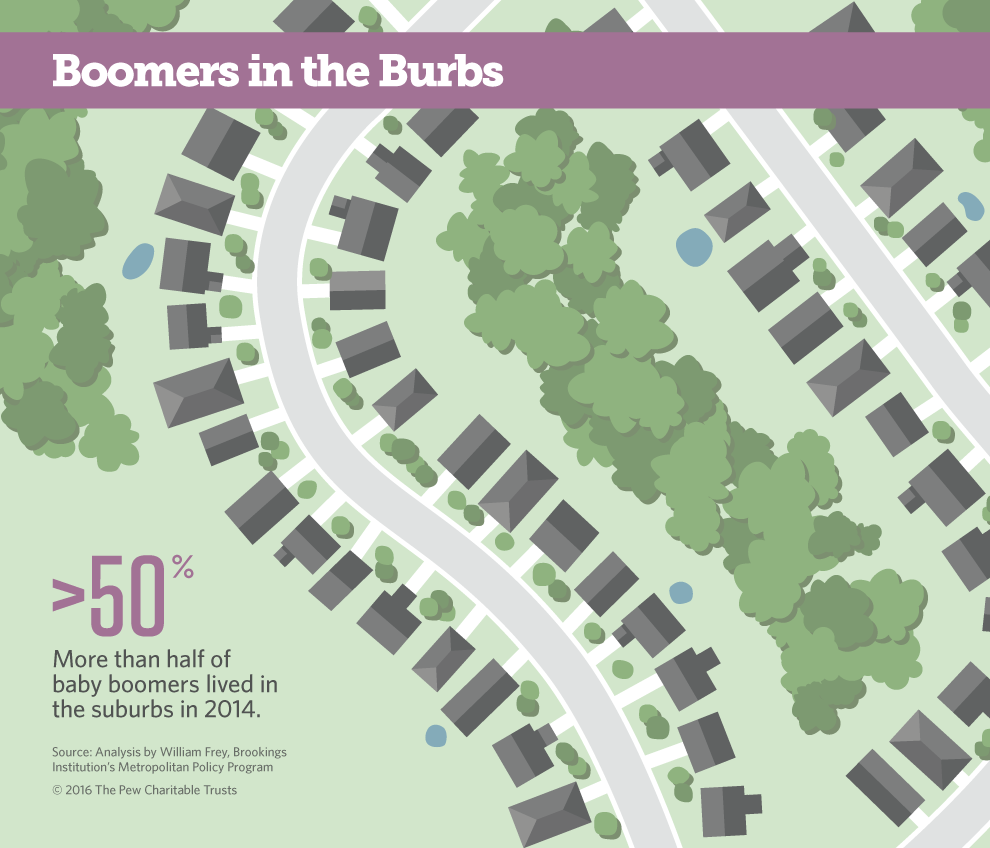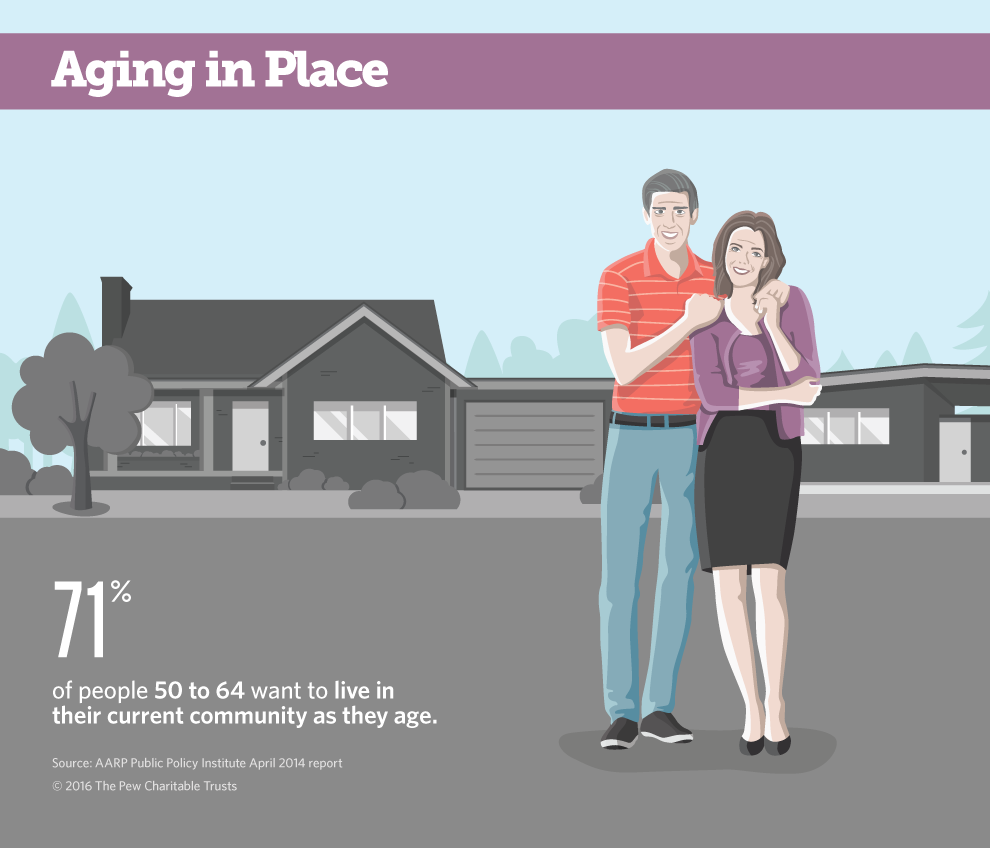Grocery Stores, Grab Bars and 'Golden Girls'

Alexandria, Virginia
To stay in the suburbs, many boomers will have to find solutions that don’t depend on government help.
This article was originally published at Stateline, an initiative of The Pew Charitable Trusts, and was written by Jenni Bergal as part of the Going Gray: How Aging Baby Boomers Will Challenge Suburbia series.
OVERLAND PARK, Kansas — Carol Gee loves her sprawling four-bedroom white ranch house in this Kansas City suburb, she sees herself living in it forever.
Just like the “Golden Girls,” she shares the house with other older, single women. Carol Gee, her sister, Paula, also unmarried and retired, and their close friend Landa Williams, a widow, all are in their mid-60s.
They moved in together for companionship and support. They chose the house because it has lots of room and is a single story, so there are no stairs to climb. Carol Gee purchased it and hired a contractor to add grab bars to the bathrooms and widen hallways and doorways, just in case one of them ends up in a wheelchair.
Someday, they understand, they may not be able to drive. So they made sure to pick a house within walking distance of shops and restaurants.
“We wanted to live near a neighborhood where we could walk to a grocery store and a pharmacy,” Carol Gee said. “Any suburb that wants to keep boomers living there, the more little ‘mini-communities’ they can create, the better.”
Unlike many of her baby boomer peers, Gee is planning ahead. But some of the suburban communities where tens of millions of boomers live — and want to remain — are struggling to do the same.
There is much to do. Most of the 75.4 million boomers live in the suburbs. As they get older and can no longer drive, they will need better public transportation. One study estimated that spending on public transit would have to increase 81 percent, to $8.6 billion, by 2030 to meet the needs of seniors who want to stay in their homes.

Suburban seniors with less money will need more affordable housing within walking distance of grocery stores and doctors. Local governments may have to help boomers maintain or repair their homes, or else contend with declining property values and tax revenue.
But seven years after the recession ended local and state budgets across the country are still squeezed. Suburbs, sometimes fragmented communities without a mayor or city council, often lack political muscle at the state level, where important decisions about spending get made. And getting government agencies that are often siloed to talk to one another about the long-term needs of an older population can be difficult.
“The politicians and elected officials are listening, but I get the sense that they don’t see this as urgent,” said Susan Franklin, who until recently ran the Aging Well Project in Jefferson County, Colorado. “We’re at the point where if we don’t get going on some of this stuff, it’s going to be too late.”
Tad McGalliard, research director for the International City/County Management Association, said many officials have a hard time thinking beyond the immediate problems they face every day.
“It’s easier to fill the potholes and keep the water flowing than to think strategically about an older population in 10 to 20 years,” he said.
Mableton (Sort of) Transformed
Mableton, an unincorporated town of 37,000 residents about 12 miles west of Atlanta, was supposed to become a suburb of the future, a place where baby boomers could grow old in apartments and condos designed for them, across the street from family town houses and within walking distance of shops and restaurants.
When regional planners selected Mableton to be a “lifelong community” seven years ago, it was filled with parking lots, decaying strip malls and gas stations. The town sprawled over 21 square miles, and its historic downtown was dominated by a working-class neighborhood of single-family homes and warehouses, an aging elementary school and some churches.
Not a whole lot has changed.
The county hired an architectural firm in 2010 that held workshops with residents and designed a comprehensive plan with a vibrant town center. County officials expected developers to snap up the modest homes and warehouses and replace them with a mix of housing, stores and offices clustered around a town green. But Mableton was hit hard by the recession, and the developers never came.
“It was all very nice, but it’s a plan that hasn’t come to fruition,” said Dave McDaniel, 66, a former treasurer of the Mableton Improvement Coalition, a volunteer civic association that advocates at the county level for better government services. “There was a lot more energy behind it back in those days. Some of that initial enthusiasm has worn off.”
To be sure, there is no guaranteed way for government to encourage private development, and the effort to retrofit Mableton hasn’t been a total failure.
The county in 2011 changed its zoning code to allow more mixed-use housing and pedestrian-friendly development. It built a walking and biking path along a busy commercial strip, and redesigned the new elementary school near the town center to fit the new look envisioned for the downtown. And it recently completed a $2.2 million project that rerouted a street in the historic town center to make way for a football-sized green space with sidewalks lined by brick edging.
But Mableton has a long way to go.
“The county is not going to build town houses or open shops,” said Robin Meyer, the improvement coalition’s vice president. “And there is nobody in state government who is going to get up every day and say, ‘Here’s this great plan, come build something.’”

Other suburbs across the country are also trying to think ahead.
Regional planners in the Kansas City, Missouri, area would like to see enhanced transit services and mixed-use retail and commercial development, in part to prepare for a graying population.
“It’s not just building communities for the aging boomers. It’s building them for the next century of folks who are going to be aging,” said Cathy Boyer-Shesol, a project manager for the Mid-America Regional Council.
One of those communities is Gladstone, Missouri, which installed new sidewalks and streetlights, added transit stops and joined a regional program that offers flexible, on-demand bus service.
To meet the needs of its aging population, Alexandria, a suburb of Washington, D.C., in northern Virginia, wants to make its streets more pedestrian-friendly, add specialty van transport services and promote housing for seniors near public transit.
Some communities have changed zoning to encourage developers to build new single-family homes using “universal design,” with features such as no-step entry and wider hallways and doorways. Those standards are mandatory in a few areas, such as Pima County, Arizona, and Bolingbrook, Illinois.
In the Denver area, where one in four residents is expected to be 60 or older by 2040, the suburban community of Wheat Ridge worked with a private developer to demolish a strip mall and turn it into a rental complex for older adults.
And “dead” malls have been retrofitted to create walkable neighborhoods with retail, offices and housing for people of all ages. In Lakewood, another Denver suburb, a developer converted the old Villa Italia Mall into Belmar, a 22-block development filled with restaurants, shops, offices and housing.
Around the country, enclosed suburban malls are being turned into mixed-use town centers, said Ellen Dunham-Jones, a professor of architecture at the Georgia Institute of Technology and co-author of "Retrofitting Suburbia". Fifteen have been redeveloped and more are planned, she said. Most of the projects are public-private partnerships. Government often helps pay for some of the infrastructure, such as street lights or sewers.
But in many suburbs that have been thinking about how to meet the needs of an aging population, the plans are mostly on paper. Making them a reality won’t be easy. “When you’re looking at transportation and land-use changes, it takes years to get the results of those policy changes into reality at the community level,” said Sandy Markwood, CEO of the National Association of Area Agencies on Aging.
Markwood and other officials who oversee programs for seniors said an infusion of government money would be great, but that’s not likely to happen. And they point out that the burden of providing services to graying boomers can’t just fall on government — whether it’s local, state or federal.
“Our city isn’t an endless pot of money,” said Karen Adcock, director of senior services for Auburn Hills, a Detroit suburb that was named an “age-friendly community” by the AARP. “There are support services like Meals on Wheels. But you need to contribute to maintaining your home. It’s not a free ride. Governments can’t do it all. They cannot and they should not.”
Housing for the Future
To stay in the suburbs, many boomers will have to find solutions that don’t rely on government help. Carol Gee and her housemates think they’ve done just that.
“At the end of the day, the huge psychological benefit of living together so outweighs the antsy-pantsy things you’ve got to compromise on with housemates,” Gee said. “We’re trying to create an environment that will work for us till our 90s and beyond.”
Another alternative some boomers are choosing is called cohousing: multigenerational or senior-focused communities of privately owned attached or single-family homes clustered around shared space. Typically there’s a “common house” with a kitchen and dining area where residents meet for meals once a week or so. Residents make joint decisions on community issues.
Harmony Village in Golden, a Denver suburb, is an example. The southwestern-style complex has 27 terra-cotta colored attached stucco town houses clustered along walkways. It has a community garden, a children’s playground, a hot tub and a large, wooden-beamed common house where residents share meals about three times a month. Houses range from the high $200,000s to about $700,000.
Ronnie Rosenbaum, 69, a divorced mother of two adult children who works part-time as a family and elder mediator, said Harmony Village residents share a commitment to ecology and sustainability. About half are boomers and many of them ski, hike or climb mountains.
“We’re not ready to just sit in front of a TV all day or go play golf. We want to change the world. We’ve never given up on that,” Rosenbaum said. “We’re active politically, physically, educationally.”
Rosenbaum said she plans to grow old in her multilevel town house, which has a bedroom and bathroom on the first floor. She figures a caretaker could live on the second floor, if need be.
“I moved here from a suburban house. I had a garage and used a garage door opener to get in,” she said. “I really didn’t know my neighbors that well. I didn’t have the relationships and the trust. It’s a very different experience here and there’s a wonderful support system.”
Alice Alexander, executive director of the Cohousing Association of the U.S., said 150 cohousing communities have been built and 12 are being constructed. Another 125 are in development.
“Villages,” membership organizations in existing neighborhoods, are another option for aging boomers. In most villages, members pay an annual fee and provide services for one another, such as transportation or light home maintenance. Non-members who live in the neighborhood also lend a hand. Villages often have a small paid staff. They sponsor social activities: luncheons, book clubs, trips to museums. And they give members lists of vetted, discounted contractors.
About 185 villages operate in 43 states and the District of Columbia and about 40 percent are in suburban areas, according to Natalie Galucia, director of the Village to Village Network, a nonprofit that provides guidance and resources to those who want to set up villages.
“I think it is a great option for boomers who are aging,” said Shari Wenokur Smith, director of the Village in the Woods, in suburban Detroit. “They need more community and they become more limited in what they can do. It’s important to establish the connection so you don’t wake up one day and say ‘I need help and I’ve got nobody.’ ”
But these alternative housing arrangements may not be affordable for working- and middle-class retirees, particularly those on fixed incomes.
“Cohousing, group houses, villages are all going to be marginal. They’re not going to take care of the bulk of boomers who don’t have adequate financial resources,” said John McIlwain, the author of "Housing in America" and a former senior fellow at the Urban Land Institute, a research center that focuses on real estate and land use. “The pressure is going to fall on local and state government. And they don’t have the money to build the housing that’s needed.”
Aging experts agree that it’s going to take a lot more work to get Mableton or any other suburb in the U.S. ready for the major demographic shifts ahead.
“There’s a tremendous amount to do. Nobody is ready in any way, shape or form,” said Kathryn Lawler, director of the Area Agency on Aging at the Atlanta Regional Commission. “No communities have transformed themselves. It hasn’t happened. But some communities will get it — and they will be the ones driving the 21st century.”





